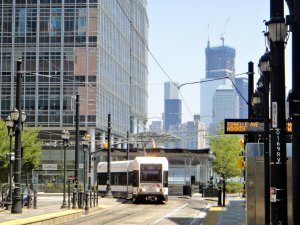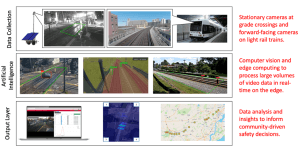
HBLR train approaching the Essex Street Station in Jersey City. Photo ©Shutterstock.
Artificial Intelligence can help reduce pedestrian and vehicle accidents along NJ TRANSIT’s Hudson-Bergen Light Rail line and beyond.
NJ TRANSIT has been awarded a $1.6 million grant from the United States Department of Transportation (USDOT) for the implementation of Artificial Intelligence-based systems designed to improve safety at light rail grade crossings.
Working with the Rutgers University Center for Advanced Infrastructure and Transportation (CAIT), the agency will equip cameras at light rail grade crossings and along railroad rights-of-way across New Jersey with cutting-edge AI algorithms to analyze real-time video data of pedestrian and vehicle travel.
This AI-powered monitoring system can rapidly parse through video data to detect, analyze, and categorize safety events and near-miss incidents. It has the capability to differentiate vehicles and pedestrians and can weigh safety factors such as time of occurrence, movement trajectory, weather conditions, and proximity to train arrival times.
“Alongside Rutgers CAIT, we are working to set a new standard in transportation safety aimed at preventing grade-crossing incidents leveraging the power of artificial intelligence,” said NJ TRANSIT President & CEO Kevin S. Corbett. “We thank the USDOT for this grant award, which allows NJ TRANSIT to continue to introduce innovative technologies that enhance safety in and around the communities we serve.”
Safety at rail grade crossings is a pressing challenge nationwide. Every three hours a person or vehicle is hit by a train in the United States, with a high number of accidents occurring at rail grade crossings.

Preliminary system design of the AI-monitoring technology.
Rutgers CAIT and NJ TRANSIT will prototype and deploy the AI technology at five light rail grade crossings along the Hudson-Bergen Light Rail (HBLR) line and equipped in one light rail train. The HBLR line supports more than 50,000 passengers daily and connects densely populated communities throughout North Jersey including Bayonne, Jersey City, Hoboken, Weehawken, Union City, and North Bergen.
With lessons learned from the HBLR deployment, the team hopes to expand in the future and further implement AI-safety solutions throughout the state’s transit network.
Xiang Liu, an associate professor and director of the Rutgers Rail and Transit Program, will lead the Rutgers CAIT team. He said that this deployment will allow NJ TRANSIT to capture near-miss incidents and better understand travel behavior to design more effective safety countermeasures.
“AI is a transformative technology that can equip the rail industry with previously untapped data,” Liu said. “This project will enhance community safety locally in New Jersey, and lessons learned can be customized and implemented in other light rail systems nationwide.”
The project was awarded to the NJ TRANSIT and Rutgers CAIT team as part of the USDOT’s Strengthening Mobility and Revolutionizing Transportation (SMART) grant program.
“Equipping rail grade crossings and critical infrastructure with AI-powered technologies allows NJ TRANSIT to collect and analyze previously unattainable safety data,” said Ali Maher, professor and director of Rutgers CAIT. “This information will serve as the foundation for data-driven safety countermeasures that will be deployed to protect communities, reduce service delays, and enhance rail reliability throughout New Jersey. CAIT is proud to support NJ TRANSIT and the USDOT in this innovative grant.”

